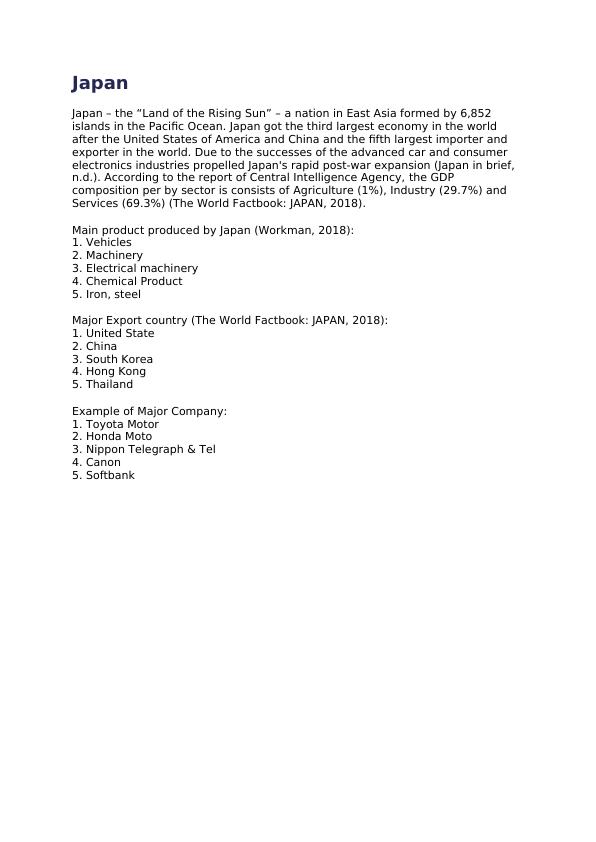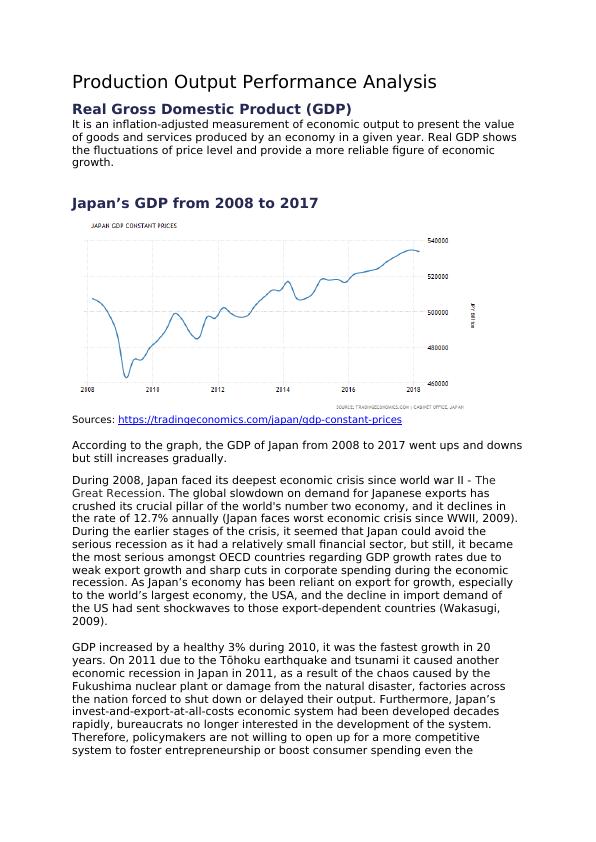Japan's Economy: Production Output, GDP, and Labor Market Analysis
Added on 2023-06-08
10 Pages3438 Words146 Views
Japan
Japan – the “Land of the Rising Sun” – a nation in East Asia formed by 6,852
islands in the Pacific Ocean. Japan got the third largest economy in the world
after the United States of America and China and the fifth largest importer and
exporter in the world. Due to the successes of the advanced car and consumer
electronics industries propelled Japan's rapid post-war expansion (Japan in brief,
n.d.). According to the report of Central Intelligence Agency, the GDP
composition per by sector is consists of Agriculture (1%), Industry (29.7%) and
Services (69.3%) (The World Factbook: JAPAN, 2018).
Main product produced by Japan (Workman, 2018):
1. Vehicles
2. Machinery
3. Electrical machinery
4. Chemical Product
5. Iron, steel
Major Export country (The World Factbook: JAPAN, 2018):
1. United State
2. China
3. South Korea
4. Hong Kong
5. Thailand
Example of Major Company:
1. Toyota Motor
2. Honda Moto
3. Nippon Telegraph & Tel
4. Canon
5. Softbank
Japan – the “Land of the Rising Sun” – a nation in East Asia formed by 6,852
islands in the Pacific Ocean. Japan got the third largest economy in the world
after the United States of America and China and the fifth largest importer and
exporter in the world. Due to the successes of the advanced car and consumer
electronics industries propelled Japan's rapid post-war expansion (Japan in brief,
n.d.). According to the report of Central Intelligence Agency, the GDP
composition per by sector is consists of Agriculture (1%), Industry (29.7%) and
Services (69.3%) (The World Factbook: JAPAN, 2018).
Main product produced by Japan (Workman, 2018):
1. Vehicles
2. Machinery
3. Electrical machinery
4. Chemical Product
5. Iron, steel
Major Export country (The World Factbook: JAPAN, 2018):
1. United State
2. China
3. South Korea
4. Hong Kong
5. Thailand
Example of Major Company:
1. Toyota Motor
2. Honda Moto
3. Nippon Telegraph & Tel
4. Canon
5. Softbank

Overview
In the cooperation between government-industry, strong work ethic, mastery
develops in high-tech and smaller allocation in defense (1% of GDP) give Japan
an opportunity to develop a technologically advanced economy opportunity. Due
to the lack of arable land Japan's gradually reliant on imported raw material and
fuels, and highly subsidized and preserved on their limited agricultural industry.
They import around 60% of its food and self-sufficient in rice. Japan also had one
of the largest fishing fleets in the world and has about 15% of the global catch.
Although the financial sector wasn't severely imperiled to subprime mortgages
their derivative instruments and weathered the initial effect of the recent global
loan crisis, the acute decline on business investment and global need for Japan's
exportation during late 2008 bring Japan further into depression. The stimulus
spending by the government helped the recovery of the economy in late 2009
and 2010, but they also foresaw the GDP growth in 2011 would slow down.
Former Prime Minister Kan suggested to opening the agricultural and services
sector to strengthen the competitiveness to overseas and boost exporting
through free-trade agreements. The reasons cause the complexity of Japan's
economy are the massive government debts, which is about 200% of GDP,
persistent deflation and an aging and shrinking population (Japan’s Economy,
n.d.).
In the cooperation between government-industry, strong work ethic, mastery
develops in high-tech and smaller allocation in defense (1% of GDP) give Japan
an opportunity to develop a technologically advanced economy opportunity. Due
to the lack of arable land Japan's gradually reliant on imported raw material and
fuels, and highly subsidized and preserved on their limited agricultural industry.
They import around 60% of its food and self-sufficient in rice. Japan also had one
of the largest fishing fleets in the world and has about 15% of the global catch.
Although the financial sector wasn't severely imperiled to subprime mortgages
their derivative instruments and weathered the initial effect of the recent global
loan crisis, the acute decline on business investment and global need for Japan's
exportation during late 2008 bring Japan further into depression. The stimulus
spending by the government helped the recovery of the economy in late 2009
and 2010, but they also foresaw the GDP growth in 2011 would slow down.
Former Prime Minister Kan suggested to opening the agricultural and services
sector to strengthen the competitiveness to overseas and boost exporting
through free-trade agreements. The reasons cause the complexity of Japan's
economy are the massive government debts, which is about 200% of GDP,
persistent deflation and an aging and shrinking population (Japan’s Economy,
n.d.).

Production Output Performance Analysis
Real Gross Domestic Product (GDP)
It is an inflation-adjusted measurement of economic output to present the value
of goods and services produced by an economy in a given year. Real GDP shows
the fluctuations of price level and provide a more reliable figure of economic
growth.
Japan’s GDP from 2008 to 2017
Sources: https://tradingeconomics.com/japan/gdp-constant-prices
According to the graph, the GDP of Japan from 2008 to 2017 went ups and downs
but still increases gradually.
During 2008, Japan faced its deepest economic crisis since world war II - The
Great Recession. The global slowdown on demand for Japanese exports has
crushed its crucial pillar of the world's number two economy, and it declines in
the rate of 12.7% annually (Japan faces worst economic crisis since WWII, 2009).
During the earlier stages of the crisis, it seemed that Japan could avoid the
serious recession as it had a relatively small financial sector, but still, it became
the most serious amongst OECD countries regarding GDP growth rates due to
weak export growth and sharp cuts in corporate spending during the economic
recession. As Japan’s economy has been reliant on export for growth, especially
to the world’s largest economy, the USA, and the decline in import demand of
the US had sent shockwaves to those export-dependent countries (Wakasugi,
2009).
GDP increased by a healthy 3% during 2010, it was the fastest growth in 20
years. On 2011 due to the Tōhoku earthquake and tsunami it caused another
economic recession in Japan in 2011, as a result of the chaos caused by the
Fukushima nuclear plant or damage from the natural disaster, factories across
the nation forced to shut down or delayed their output. Furthermore, Japan’s
invest-and-export-at-all-costs economic system had been developed decades
rapidly, bureaucrats no longer interested in the development of the system.
Therefore, policymakers are not willing to open up for a more competitive
system to foster entrepreneurship or boost consumer spending even the
Real Gross Domestic Product (GDP)
It is an inflation-adjusted measurement of economic output to present the value
of goods and services produced by an economy in a given year. Real GDP shows
the fluctuations of price level and provide a more reliable figure of economic
growth.
Japan’s GDP from 2008 to 2017
Sources: https://tradingeconomics.com/japan/gdp-constant-prices
According to the graph, the GDP of Japan from 2008 to 2017 went ups and downs
but still increases gradually.
During 2008, Japan faced its deepest economic crisis since world war II - The
Great Recession. The global slowdown on demand for Japanese exports has
crushed its crucial pillar of the world's number two economy, and it declines in
the rate of 12.7% annually (Japan faces worst economic crisis since WWII, 2009).
During the earlier stages of the crisis, it seemed that Japan could avoid the
serious recession as it had a relatively small financial sector, but still, it became
the most serious amongst OECD countries regarding GDP growth rates due to
weak export growth and sharp cuts in corporate spending during the economic
recession. As Japan’s economy has been reliant on export for growth, especially
to the world’s largest economy, the USA, and the decline in import demand of
the US had sent shockwaves to those export-dependent countries (Wakasugi,
2009).
GDP increased by a healthy 3% during 2010, it was the fastest growth in 20
years. On 2011 due to the Tōhoku earthquake and tsunami it caused another
economic recession in Japan in 2011, as a result of the chaos caused by the
Fukushima nuclear plant or damage from the natural disaster, factories across
the nation forced to shut down or delayed their output. Furthermore, Japan’s
invest-and-export-at-all-costs economic system had been developed decades
rapidly, bureaucrats no longer interested in the development of the system.
Therefore, policymakers are not willing to open up for a more competitive
system to foster entrepreneurship or boost consumer spending even the

End of preview
Want to access all the pages? Upload your documents or become a member.
Related Documents
Economic Performance of Japan: Real GDP, Unemployment, and Price Level Analysislg...
|13
|2771
|494
Economics Assignment 2022lg...
|12
|2818
|21
Economics: Production Output Performance, Unemployment, and Price Level Analysislg...
|15
|3073
|20
Production Output Performance in Singaporelg...
|10
|2755
|27
Performance of USA Economy from 2008 to 2018lg...
|16
|3141
|43
Assignment on Economics and GDP 2022lg...
|13
|3156
|16
